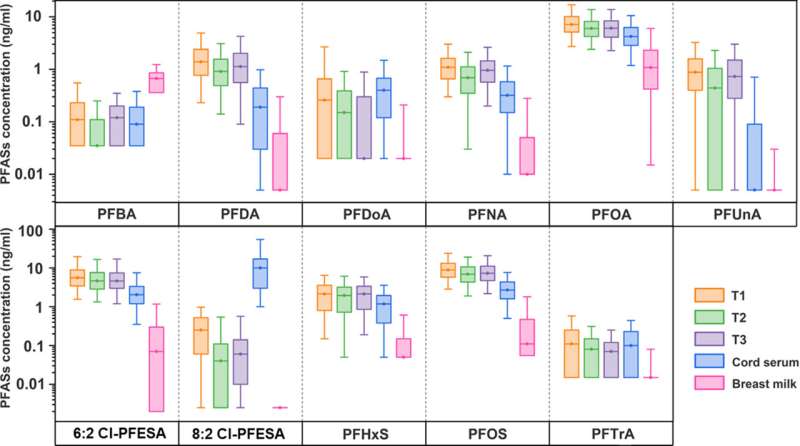This article has been reviewed according to Science X's editorial process and policies. Editors have highlighted the following attributes while ensuring the content's credibility:
fact-checked
trusted source
proofread
Alarming study unveils how forever chemicals transfer from mothers to newborns

Polyfluoroalkyl substances (PFAS) are a class of chemicals extensively used in consumer goods production due to their hydrophobic and oleophobic properties and stability. However, their persistence in the environment and bioaccumulation in living organisms have sparked concerns about potential health effects. Previous studies have linked PFAS exposure to various adverse outcomes, including developmental issues in children.
A recent study published in Eco-Environment & Health on May 8, 2024, has highlighted the levels, health risks, and transport protein binding capabilities of per- and polyfluoroalkyl substances (PFAS) in early life based on the Shanghai Maternal-Child Pairs Cohort.
Found in maternal serum, cord serum, and breast milk, these synthetic chemicals pose potential health risks for infants. Led by a team from School of Public Health at Fudan University, the researchers meticulously analyzed the transfer mechanisms and impacts of these persistent chemicals, providing crucial insights into their pervasive presence from pregnancy to lactation.
Employing high-performance liquid chromatography-tandem mass spectrometry, the study analyzed 16 types of PFAS in 1,076 mother-child pairs. It revealed the detection rates and median concentrations of perfluorooctane sulfonate (PFOS), perfluorooctanoic acid (PFOA), and 6:2 Cl-PFESA, with PFOS most prevalent in maternal serum.
Notably, placental transfer efficiency of PFAS was higher than breastfeeding transfer, suggesting that these chemicals are more likely to cross the placenta and accumulate in the fetus. Additionally, the research utilized molecular docking to simulate the binding of PFAS to transport proteins, potentially influencing their distribution and transport within the body.
These findings underscore the need for tighter PFAS regulations and further research into their environmental and health effects.
Ms. Yaqi Xu, lead author of the study, states, "Our findings are crucial for developing strategies to protect infants from the potentially harmful effects of PFAS exposure. Understanding the pathways and risks associated with these chemicals can lead to better regulatory policies and protective measures for the most susceptible among us."
The implications of this research are profound, particularly for public health policies and infant safety. By identifying specific PFAS compounds more likely to transfer through the placenta and into breast milk, preventive measures can be more effectively targeted. Moreover, the study's findings could influence future guidelines on the use of PFAS-containing products by pregnant women and nursing mothers.
More information: Yaqi Xu et al, Early-life exposure to per- and polyfluoroalkyl substances: Analysis of levels, health risk and binding abilities to transport proteins, Eco-Environment & Health (2024). DOI: 10.1016/j.eehl.2024.04.007




















